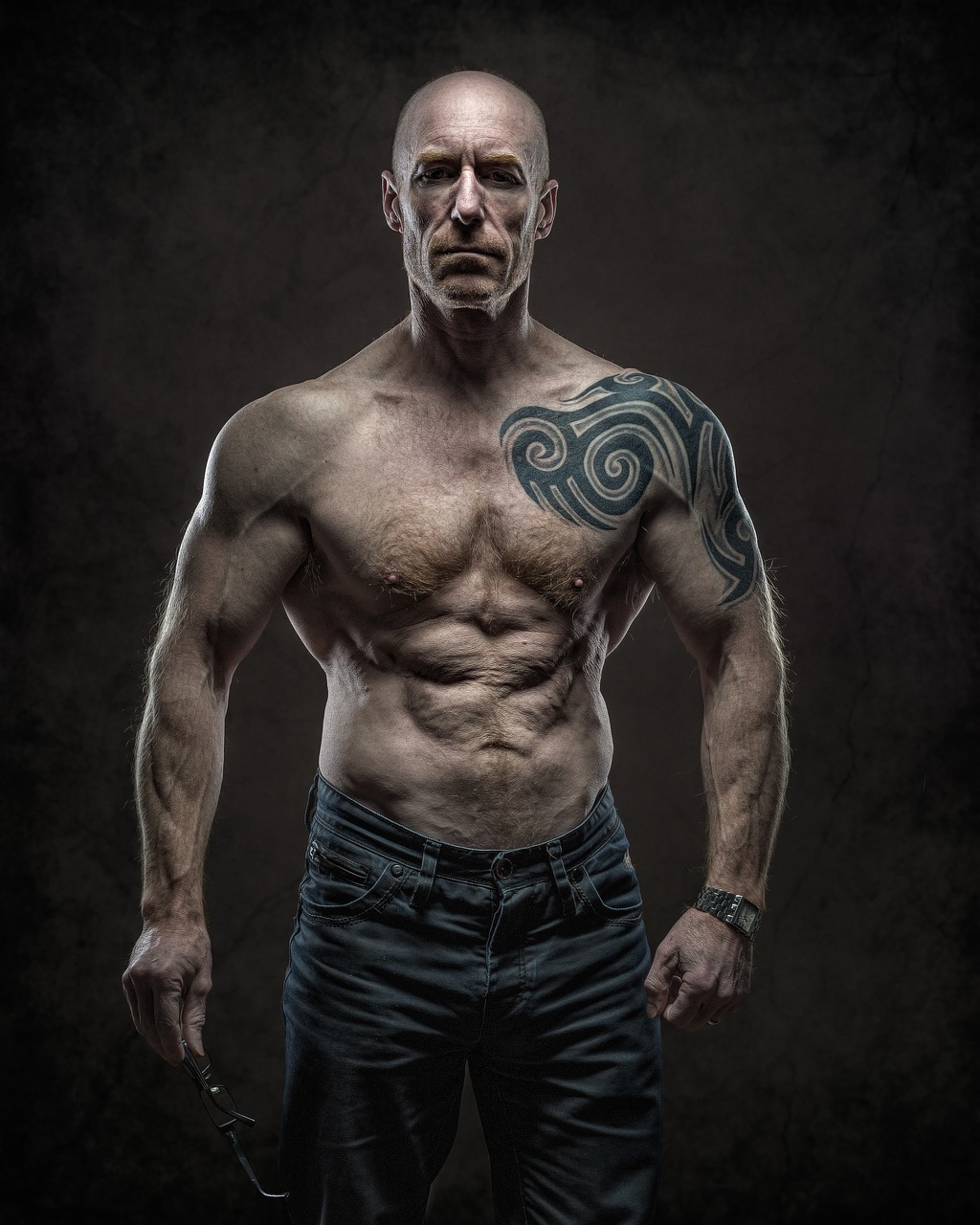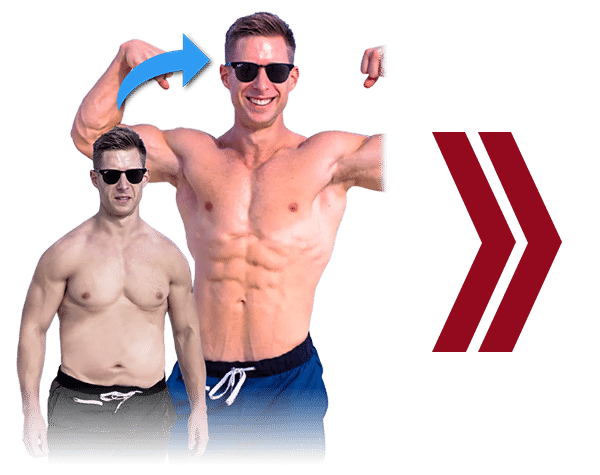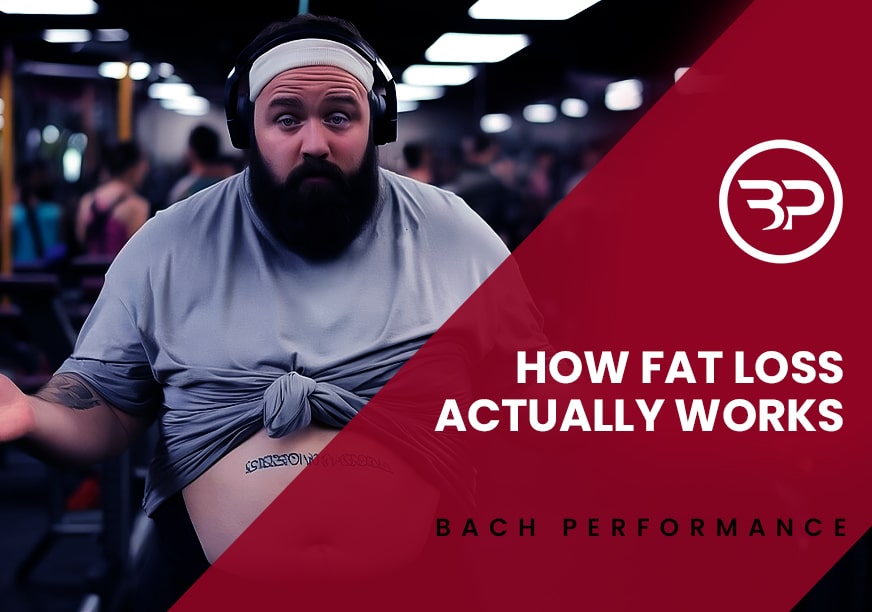Building Muscle After 40: Build Muscle Fast Without Living In The Gym
November 26, 2021
If you’re interested in building muscle after 40 you can’t do the same workouts you did at 20 and expect the same results.
You have more stress and responsibility than you did in the past.
Your energy levels and motivation to work out may have waned.
Your joints have taken a pounding over the years, and the minor aches 5-10 years ago are regular reminders that you’re no longer invincible.
If you splurge on your diet, your gut gives you fits. Inflammation seeps into your body, and looking at a pizza and beer deposits a fanny pack of mashed potatoes around your gut.
Your body doesn’t respond to training the way it did in the past.
Father time is undefeated.
The good news is you can still build muscle, lose fat, and transform your body if you’re willing to adapt. Done correctly, you’ll be able to train hard, optimize your health, and look great for decades to come.
Is It Posible To Build Muscle After 40? What to Expect
If you want to build muscle without losing body fat, your first step is to get lean.
Most men optimally build muscle when they’re between 12-15% body fat. Visually, you should have some abdominal definition.
Related: https://bachperformance.com/accurately-estimate-body-fat-percentage/
When you’re leaner, your testosterone levels will be higher, and your insulin sensitivity will improve. These hormonal adaptations make it easier for you to build more muscle without gaining body fat.
The focus of this article is on building muscle after 40, so I’m not going to go full scale into the fat loss process. The truth is, you can expect to lose between 1-3 pounds per week if your training, nutrition, and lifestyle are all in line.
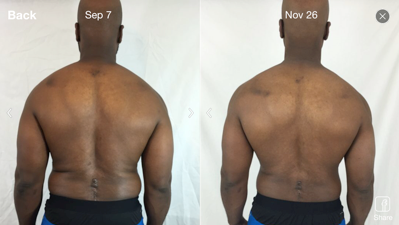
Fat loss is a sprint. Building muscle after 40 is a journey.
How Fast Can You Build Muscle After 40?
Your muscle growth is going to be dictated by many factors, including past training experience, existing muscle growth, and genetics.
Further, optimal muscle growth requires a caloric surplus, progressive overload in the gym, and adequate sleep and recovery. Without all three of these elements dialed in, your progress will be slower.
As illustrated by Alan Aragon, the amount of lean muscle you can build depends on where you begin with your training.

Women can expect to gain about half the muscle listed below after 40 years old following the same protocols I will outline.
Realistically, as a beginner, you’re looking at 1-2 pounds of lean muscle growth per month or 12-24 pounds of muscle per year.
.5-1 pound of muscle growth per month and 6-12 pounds of muscle as an intermediate lifter.
.25-.5 pounds of muscle per month and 3-6 pounds per year as a more advanced lifter.
Most lifters are in the beginner/intermediate lifting stage, even if they’ve been training for years. There is still significant potential for building lean muscle.
The advanced lifters, those with non-stop training for 10-15 years and are built like a Mac-truck grow much slower.
So, the question is, how long should you commit to building lean muscle if you want to change your physique?
If you’re not spending at least 4-6 months focused on lean muscle growth, you’re wasting your time. The majority of guys never build the body they want because they oscillate between bulking at cutting weekly or monthly.
As soon as they start to grow, they feel self-conscious about adding body fat and quit.
Once they start to diet, they feel they’re not making progress fast enough, or they think they’re too skinny and start to bulk.
Many lifters stay stuck in this cycle for years. Despite their hard work and knowledge in the gym, they never change their body and remain stuck.
My advice?
Get lean first. Your joints, testosterone levels, and health will be much better.
Focus on 4-6 month blocks to build lean muscle, knowing you will gain a little body fat, but you can take it off quickly.
If you commit with this process in mind, you can transform your body.
Further Reading: https://bachperformance.com/how-much-muscle-can-you-gain-in-a-month/
Weight Training After 40
Let’s face it: there is no one size fits all workout that works for everyone in every situation. But when you’re over 35, you need a maximally efficient workout. Your time is at a premium.
There are two training splits that stand above the rest:
- The upper-lower training split.
- Our PPLV split, which stands for pull, push, lower, vanity.
The Upper-Lower Training Split:
The upper-lower training split involves alternating between training your upper and lower body. In most cases, four workouts are completed in a seven-day training split.
Here’s a sample week:
- Monday: Upper Body (Push Strength Emphasis)
- Tuesday: Lower Body (Squat Pattern Strength Emphasis)
- Wednesday: Off/go for a 60-minute walk.
- Thursday: Off/go for a 60-minute walk.
- Friday: Upper Body (Pull Strength Emphasis)
- Saturday: Lower Body (Hinge Pattern Strength Focus)
- Sunday: Off
Why an Upper Lower Split?
Optimal muscle growth takes place when you have a balance of progressive overload without overstressing your joints. This split is designed so you can hit muscle groups multiple times in a given week.
You may build muscle fast with higher training frequency (compared to your classic body part split) due to increased muscle protein synthesis, more frequent spikes in anabolic hormone levels, and improved insulin sensitivity.
The downside to upper-lower workout splits:
Depending on your health, training your lower body twice per week can be brutal on your knees and lower back. Much of this comes down to exercise selection. Barbell squatting or conventional deadlifts many times per week can create more stress on your joints than a stimulus for your muscles.
The PPLV Split
The PPLV (push, pull, lower, vanity) split takes the classic push-pull-lower training split and adds a day to maximize muscle growth.
Here’s what each day would emphasize:
Pull: Hip hinge (deadlift variation), 2x rows (dumbbell one-arm rows, landmine rows), pull-ups, biceps/rear delts.
Push: Horizontal push (bench press), overhead press, chest, triceps, shoulders
Legs: Squat (squat variation, hinge (Romanian deadlift), lunge, glutes, hamstrings, quads, calves, adductors.
Vanity: Whatever muscle group you want to emphasize for 4-6 weeks. If I’m designing you a workout, we pick a stubborn muscle group you want to highlight and use this day to attack it.
Many of my clients will rotate through emphasizing arms/ shoulders to build them. Occasionally, this workout turns into a “performance” day with cleans, sprints, sled work, and other athletic-based training.
I prefer to start training cycles on “Saturday” as the weekend allows more time to train for the time-strapped lifter. I prefer to start with a “pull” day to provide an extra day of rest between the pull and legs days. This allows you to hit a deadlift pattern on your “pull” day while giving your joints an extra break.
Saturday: PULL
Sunday: Push
Monday: Off
Tuesday: Legs
Wednesday: Off
Thursday: Vanity
Friday: Off
Why the PPLV Training Split?
The scheduling of these workouts makes it easier to stay consistent.
There is less intrusion into your work and life responsibilities with only two workouts during the work week.
If you’ve previously trained as an athlete or powerlifting and prefer to train based on a movement pattern, this split works seamlessly into your preferences. The vanity day allows you to attack weak points to bring up your physique.
Picking the Right Training Split For Mass
The biggest mistake most lifters make is sticking with what worked in the past despite changes in sleep, stress, and recovery.
You can only grow when you recover from training. So, if you’re sleeping less and more stressed, your training must adapt.
The best way to adapt is to perform more, shorter workouts. This creates some level of consistency in a chaotic schedule. Training more often also reinforces the habit and keeps busy folks inline in other areas of life, like nutrition.
Performing more but shorter workouts can increase muscle protein synthesis. A 2010 study analyzed training frequency and the anabolic response (1). Researchers found that repeated bouts of resistance exercise and protein ingestion trigger an anabolic response and growth.
In drug-free lifters, muscle protein synthesis stays elevated for 24-36 hours post-workout.
How Heavy and How Long Should Your Workouts Take?
The principles of building muscle don’t change as you get older. But how you apply them will.
You’ll need progressive overload to grow.
Best way to overload your muscles is to gradually add weight to the bar, optimize your technique, and “feel” your muscles contract on every rep.
If improving testosterone levels is a critical goal in your training, research has shown that the best results for enhancing testosterone levels come from heavy resistance training (70-90% 1RM).
This roughly translates to lifting a weight you lift 3-12 times.
Increases in cortisol levels and decreases in testosterone have been shown in multiple studies when training goes longer than an hour.
You don’t need to limit your workouts to 60 minutes, but there’s a point of diminishing returns with longer, higher volume, train-to-failure workouts.
During training, testosterone levels rise, but soon after the workout, there’s an increase in cortisol. That’s where eating carbs after a workout is crucial. When your workouts finish, your insulin sensitivity is at its peak.
By consuming carbs, you’ll leverage post-workout insulin sensitivity, buffer cortisol, refill glycogen stores and increase muscle growth.
Over time, strength training can influence the pituitary and possibly hypothalamic levels, leading to increased serum levels of testosterone (2). The caveat here is you must eat and sleep as hard as you train.
What does this mean for the average person who benches three times per week with plenty of interval training and chronic dieting? If you want to work out hard and optimize your testosterone levels, your sleep and nutrition have to follow suit.
The Perfect Rep For Building Muscle Over 40
In your early years of lifting, you can get away with sloppy form without any problems. That isn’t the case when you’re in your 30’s and 40s.
The longer you train, the more critical your mind-muscle connection becomes. When you can feel a muscle contracting (versus focusing on completing the rep), you’ll increase the number of muscle fibers you recruit. Doing so helps you get more bang for your buck with less stress on your joints.
I can’t highlight how important this is. Your body doesn’t know the “weight” on the bar; all it knows is it must create tension to overcome whatever you’re doing.
If you can create more tension in your muscles by slowing down your tempo and mentally engaging your muscles on each rep, you’ll build muscle while preserving your joints.
Training Tempo: Grow Your Muscles and Protect Your Joints
Just as your body doesn’t know the weight on the bar, it doesn’t know “reps” either. Your body gets fatigued based on how long your muscles are under tension.
In other words, don’t obsess over the amount of weight on the bar anymore. Focus on the contraction of each muscle.
By slowing down your tempo, you’ll improve your mind-muscle connection and create more metabolic stress and muscular damage–two crucial factors that drive muscle growth.
Try a 3111 tempo. The first “3” is eccentric or negative. The second number is the “bottom” of the rep; in this case, take a one-second pause.
The third number is the concentric or the “up” phase, so you should lift “up” in one second.
The final number is the end of the rep before beginning the next. In this case, a one-second pause between each rep.
During your next workout, emphasize slowing down your tempo.
If you usually focus on getting your reps in, emphasizing tempo is a powerful way to create a new stimulus and grow faster.
Is Cardio More Important In Your 40’s?
Like it or not, once you hit your mid 30’s training for health becomes more important for heart and brain health. Double that for being in your 40’s
Being in great cardiovascular health improves work capacity, so you can train hard in the gym and improve nutrient utilization, meaning you’ll more effectively use your carbs, fats, and proteins to build muscle, not fat.
But will too much Cardio prevent muscle growth?
Take a look at this short post on Instagram:
Weight training and Cardio are on opposite sides of the spectrum regarding how your body responds to them.
Resistance training sends a cascade of signaling proteins (mTor) that trigger muscle protein synthesis, so you grow bigger and stronger.
Aerobic training sends signals to genes to develop mitochondria (increased mitochondrial density) to boost energy production and make you less likely to wheeze when running around the block.
With aerobic exercise, AMP-K is triggered and can block the molecular signals for building muscle (mTor).
BUT…The signals for resistance training do NOT block the signals to improve cardiovascular health.
Here’s what all this means for you:
Doing too much Cardio can impair muscle growth. But it depends on how advanced you are in the gym, what kind of Cardio you’re doing when you’re doing it, and your recovery.
It’s not that Cardio is good or bad. When Cardio is misapplied, it can lead to muscle loss (and stress), while Cardio ignored can lead to poor health, shoddy recovery, and earlier death.
Here’s what you need to follow to leverage the benefits of Cardio without crushing your ability to build muscle.
- Do Cardio on non-lifting days to avoid conflicting signals to your body.
- In a pinch, do Cardio at the end of your weight lifting.
- Walk 10,000 steps/day. If you do this, you may not need a regular cardio-based workout.
- Try 15-20 minutes of HIIT like sprint work (with recovery) or…30-40 minutes of steady-state Cardio at 220-age x.6-.7= target heart rate 2x/week
- Use low-impact methods like biking, hiking, airdyne, etc.
So, what about running or sprinting?
If you’re going to run or sprint, ease your way into it. Steady-state “jogging” can wreak havoc on your joints and raise cortisol.
Sprinting is an intense activity that requires a build-up process to do it safely.
When it comes to Cardio, consistency is more important than perfection. In both cases, apply the recommendations listed above. Pick what you will tolerate consistently and get it done.
More here https://www.t-nation.com/workouts/tip-the-twice-per-week-sprint-workout/
Being in cardiovascular shape improves nutrient utilization and overall health.
Muscle Building Diet After 40
If you want to build muscle over 40, then you’ll need a calorie surplus. Don’t make the mistake of trying to lose fat and build muscle at the same time. Your body isn’t optimized for it like it was in your teens and 20’s.
Instead, get lean first. Then commit to the muscle-building process.

How Many Calories?
To cut fat gain and maximize muscle growth, aim for a calorie surplus of about 10% and increase to 15-20% if needed. Your body can only build muscle so fast. If you try to speed up the process by eating more, you won’t gain muscle faster; you’ll gain body fat faster.
There are dozens of equations out there for building muscle and losing fat. Don’t get bogged down trying to find the best one, as they’re all estimates anyway.
Take your body weight x.15 (15%), and you’ll have a good idea of your maintenance calories. You’ll want to eat more than this.
How Much Protein For Building Muscle Over 40
If you want to optimize muscle growth, aim to have between .82 and 1g of protein per 1 pound of bodyweight.
It appears .82/g/lb of bodyweight is the upper limit of protein needed to derive maximum protein synthesis, according to this 2011 study by Phillips and Van Loon. (3)
So, why the recommendation of 1g/lb/ of bodyweight?
First, it’s easier to remember.
Second, 30% of your calories are from protein and burned off during digestion. If you’re going to overeat one macro, it’s better to overeat protein than carbs or fat.
So, what’s the difference between 1g and .82g?
Most protein scoops are 25-30 g per serving. Using a 180lb man as an example, 180x.82= 147 g of protein per day. And 147+30? 177g, or damn near 1g of protein per 1/b of bodyweight.
My Take
Consuming .82 g of protein per 1 lb of body weight is enough.
But if 1g of protein per 1 lb of bodyweight is working for you, it’s fine to stick with it.
Carb Intake For Muscle Growth
Most people get less active with age and lose lean muscle. Insulin sensitivity decreases as you get older. Many people over 40 jump on the low-carb bandwagon, thinking it’s a magic panacea for staying leaner.
The good news? These age-related changes can be negated with regular, hard training (as described above) and eating high-quality foods.
High-fat diets are no better for fat loss than high-carb diets when calories and protein are equal.
And for muscle growth? High-fat diets are sub-optimal for muscle growth for three reasons, according to my friends at Examine.com
- By reducing carb intake, keto diets reduce insulin levels and inhibits mTOR, which triggers muscle protein synthesis
- Keto may promote AMPK phosphorylation, which can inhibit anabolic pathways.
- Keto diets can suppress appetite and make it harder to eat enough to build lean muscle.
It’s not that high-fat diets are bad. But they’re not optimal if you want to build muscle.
Carbs Role In Muscle Building
When you look at bodybuilders and athletes with the best physiques in the world, they’re fueled with carbohydrates like sweet potatoes and rice, not bacon grease and buttered coffee.
Aim for at least 2 g of carbs per 1 lb of bodyweight, which should come out to 40-50% of your calories for the day.
Aim for 50-100g of carbs around your workout to maximize post-workout insulin sensitivity. I prefer highly-branched cyclic dextrin with my post-workout. Your best sources will be oatmeal, white rice, legumes, potatoes, and squash throughout the rest of the day.
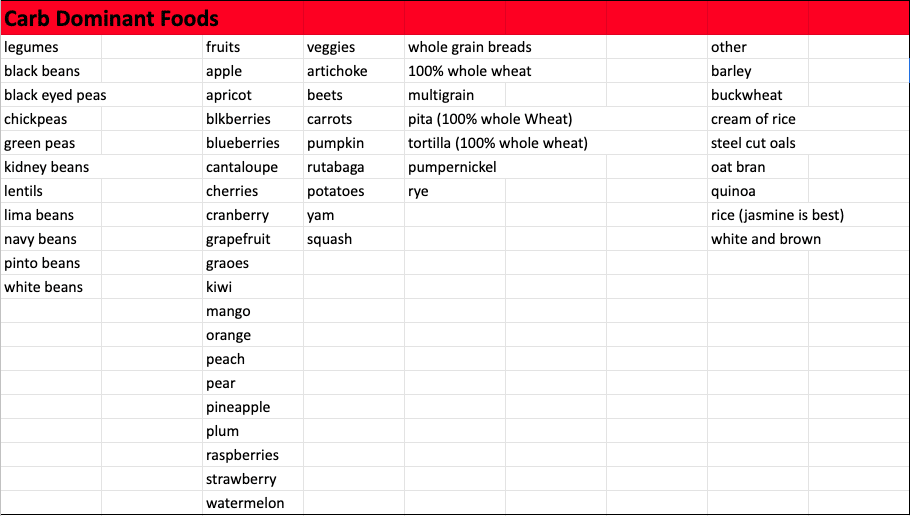
The Muscle Building Mechanism:
Muscle tissue glucose uptake is stimulated by insulin, which triggers the migration of glucose and amino acids to muscle cells. This promotes protein synthesis, which is kind of fuckin’ important for building lean muscle.
When you work out, muscular contractions increase the facilitated diffusion of glucose into muscle cells more, promoting greater insulin sensitivity.
When you’ve eaten carbs and trained, you’ll have more glucose in your blood. Your body will use that glucose over stored fuel to build lean muscle.
If you think you’re getting pudgy by eating a banana before your train, look at the rest of your diet, there’s something else wrong. Carbs fuel high-performance muscle growth.
Eat Ample Fat to Support Healthy Hormone Levels
Researchers have found that eating around 0.8 to 1 gram of fat per kilogram of body weight is adequate for optimal hormone production (4,5), which is crucial for optimizing testosterone. In most cases, this comes out to having 20-30% of your calories from fat.
The types and quality of the fats you consume play a large role in health and hormone function. Omega-3 fatty acids help the stabilization of hormones, the rebuilding of cells, and sex hormone function. Omega-6 hormones and trans-fats have negative impacts on testosterone and hormone function.
Avoid potential inflammatory vegetable oils and processed foods. Aim to get your fat from natural animal sources (pass the fish), omega-3 fish oil, nuts, and seeds.
Eat Foods That Had A Face.
The older you get, the more food quality matters. Yes, calories are king. But Everyone has a unique reaction to different foods. With age, you notice your body doesn’t handle certain foods the way it once did.
Eating a diet full of processed foods, oils, alcohol, etc., can wreak havoc on your hormones, inflammation, and health.
My advice?
When it comes to food, aim to eat foods that once had a face or grew on the earth.
Testosterone Optimization Over 40
If you’ve caught a late-night infomercial during a football game, there’s no doubt you’ve been bombarded with magic pills and elixirs designed to help men optimize their testosterone.
After the age of 30, men’s testosterone levels decrease by about 1% every year. This leads to less muscle, more body fat, less energy, and yes, fewer rock hard boners.
The primary factor here is testosterone, the GOAT of muscle-building hormones and male sexual function.
Testosterone is interlinked with our body’s feel-good hormone, dopamine, and your motivation, mental health, cognitive function, and heart health.
Before going further, I’m not a doctor, and this does not convey medical advice.
The best way to gauge your testosterone levels is to get tested by a doctor and consult with an endocrinologist.
It’s impossible to know whether further intervention is needed without blood work as a baseline.
Most guys never get their testosterone levels checked for $100, then proceed to spend thousands of dollars on sketchy supplements and steroids before even knowing whether they have low testosterone levels or not.
Numerous proven lifestyle adjustments may help you optimize your testosterone levels to build muscle and lose fat.
- Consume 5000 Iu’s of vitamin D/daily.
- Get natural sunlight within the first 30 minutes of waking up.
- Supplement with magnesium and zinc.
- Reduce alcohol and drug consumption. Ideally, eliminate it.
- Compete in an athletic challenge.
- Actively reduce stress: Meditate, disconnect from electronics/media, and start a gratitude practice.
- Consume at least 20% of your calories from fat.
- Get lean (12-15% body fat for men).
The Miracle Drug For Men Over 40 Who Want To Get Jacked: Sleep.
Getting 7-8 hours of quality sleep is the not-so-sexy secret to building muscle after 40 and optimizing your healthx. Proper sleep is crucial as you get older because it helps optimize hormone function from testosterone and growth hormone to insulin sensitivity.
The majority of testosterone release occurs at night. If you sleep like shit, your hormone levels will soon live in the shitter.
A lack of sleep has been shown to increase inflammation and cortisol, exacerbating two key issues already at stake with the aging process.
So, how much sleep do you need?
I know stress, kids, and life can make this challenging, but you need to get 7-8 hours of sleep. It’s the most important thing you can do for your health, even more than training.

Consider this sleep study (6). Researchers first had participants sleep from 10 PM to 8 AM. This was their rested condition. In the final week, participants spent eight nights getting only 5 hours of sleep (12:30 AM to 5:30 AM).
The result? In just one week of sleeping 5 hours per night, their testosterone levels plummeted by 10-15%.
If you’ve been undersleeping for years, imagine what a cumulative wrecking ball that has been on your testosterone levels.
By sleeping 5 hours per night or less, you’re giving yourself testosterone levels to someone 10-15 years older.
Related: 9 Proven Sleep Strategies https://bachperformance.com/nine-simple-sleep-strategies-for-busy-weightlifters/
Supplements For Building Muscle After 40
Supplements are by no means a fix-all. But the right supplements at the right time can shore up nutrition gaps and make getting in shape easier. A high-quality protein powder is something I recommend across the board.
If we’re looking to build muscle (and optimize anabolic hormone levels), Here’s what I recommend from Legion Athletics (use code BACH to save 20%)
Zinc+ Magnesium. Supplements like ZMA or Legion’s multivitamin Triump contain magnesium and zinc designed to attack common nutrient deficiencies, promoting optimal sleep, recovery, and hormone levels.
Magnesium deficiency is the second most common dietary deficiency in the Western world (right behind vitamin D).
Magnesium plays a role in over 300 chemical reactions inside the body, including many revolving around sleep, recovery, and stress management—all of these which play crucial roles in optimizing testosterone (7).
Zinc is involved in optimizing testicular function, reproductive health, and brain and immune function (8). Decreases in the mineral content of most foods today, along with heavy exercise, will cause many people to be low in magnesium and zinc, making supplementation a no-brainer.
Vitamin D: In addition to natural sunlight, supplementation is recommended to improve immune function, mood, and testosterone levels. Vitamin D acts more like a hormone than a vitamin, and the majority of people suffer from alarmingly low levels of it.
Creatine: Evidence is mixed as to whether it directly improves testosterone levels. That said, it’s been proven to help you build and preserve strength, muscle, optimize cognitive function, and boost mitochondrial function. People with low T struggle with all of those maladies, so adding 5 grams of creatine per day will improve gym performance and health, particularly in those with low testosterone.
The Secret to Success Building Muscle After 40: Consistency
Building muscle after 40 is simple but hard. Don’t make it harder on yourself by training like you’re 22.
The most important factor in building your dream body is staying consistent. No doubt, life throws us all curve balls that make finding time to train hard and eat right a choir.
The key to your success is being able to pull back and adjust without stopping completely.
But the impact of a strong, healthy, and muscular physique bleeds over into every other area of your life. If you’re interested in getting step-by-step coaching to get visible abs and build lean muscle, you may be a good fit for our converted Bach Performance Physique Coaching Program.
We limit access to ten clients per month. But if you’re sick and tired of spinning your wheels and not having the body you deserve, let’s chat.
All you need to do is fill out a short application here, and my team and I will reach out to help you.
Apply Now: https://bachperformance.com/coaching
Resources
West, Daniel WD, Phillips, Stuart M., “The Anabolic Processes in Human Skeletal Muscle.” Researchgate. October 2010. The Physician and sports medicine 38(3):97-104DOI:10.3810/psm.2010.10.1814
Hakkinen, K., et al. “Neuromuscular and Hormonal Adaptations in Athletes to Strength Training in Two Years.” Hakkinen, 1988, journals.physiology.org/doi/abs/10.1152/jappl.1988.65.6.2406.
(Sports Sci. 2011;29 Suppl 1:S29-38 (2011). Retrieved August 9, 2017,Dietary protein for athletes: From requirements to optimum adaptation.
Ouladsahebmadarek et al. 2014.”Hormonal and Metabolic Effects of Polyunsaturated Fatty Acid (Omega-3) on Polycystic Ovary Syndrome Induced Rats under Diet.” PubMed Central, 1 Feb. 2014.
Lidia Mínguez-Alarcón et al. 2017.”Fatty Acid Intake in Relation to Reproductive Hormones and Testicular Volume among Young Healthy Men.” PubMed Central (PMC), 2017, www.ncbi.nlm.nih.gov/pmc/articles/PMC5312216.
Effect of 1 Week of Sleep Restriction on Testosterone Levels in Young Healthy MenFREE.” PubMed Central (PMC), 1 June 2011, www.ncbi.nlm.nih.gov/pmc/articles/PMC4445839.
Cinar V, Polat Y, Baltaci AK, Mogulkoc R, “Effects of magnesium supplementation on testosterone levels of athletes and sedentary subjects at rest and after exhaustion,” Biol Trace Elem Res. 2011 Apr;140(1):18-23.
C D Hunt, P E Johnson, J Herbel, L K Mullen, “Effects of dietary zinc depletion on seminal volume and zinc loss, serum testosterone concentrations, and sperm morphology in young men.” The American Journal of Clinical Nutrition, Volume 56, Issue 1, July 1992, Pages 148–157.


